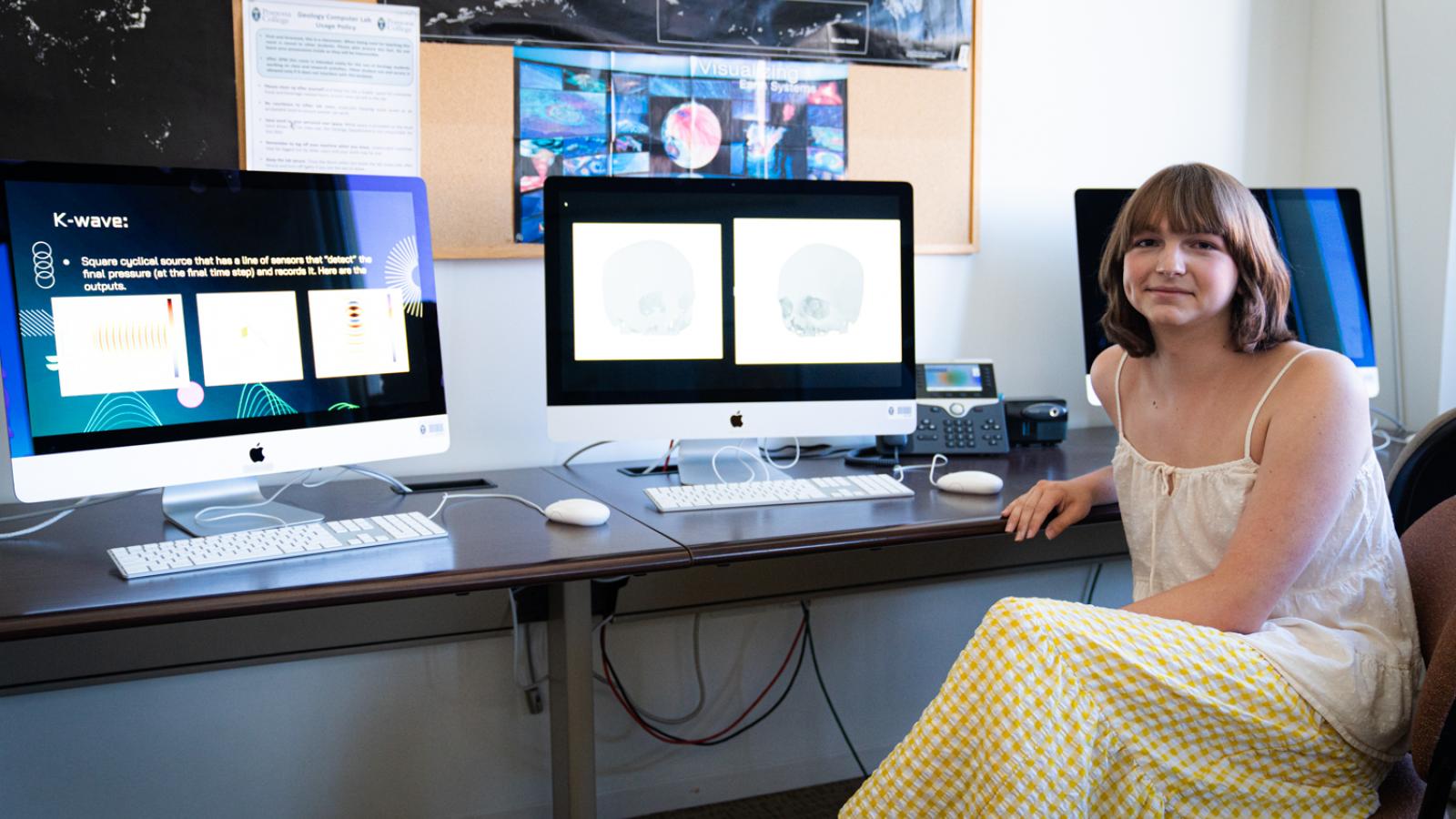For years, medical researchers seeking new treatments for chronic brain diseases such as Parkinson’s and epilepsy have been stymied by the blood-brain barrier. A natural defense against blood-borne toxins and pathogens that could harm the body’s most vital organ, it also prevents the targeted delivery of most pharmaceuticals as well.
This summer, two Pomona College students in the Summer Undergraduate Research Program are involved in promising research that may eventually lead to a solution to this vexing problem. Rising sophomores Ruth Vesta-June Gale ’25 and Stanley Su ‘25 are working with Ami Radunskaya, Lingurn H. Burkhead Professor of Mathematics, on mathematical modeling showing how ultrasound could disrupt the blood-brain barrier just enough to allow encapsulated drugs to enter the brain.
Radunskaya uses the example of Parkinson’s disease to show how the new approach might provide breakthroughs. The current treatment involves taking a chemical in pill form that converts to dopamine in the brain. But, she notes, “only a teeny bit gets through the blood-brain barrier to where it needs to go.” The rest is distributed throughout the body, which can sometimes lead to dyskinesia—involuntary and uncontrolled movement. Pinpoint-accurate drug delivery to the brain could potentially lead to better patient outcomes.
Radunskaya is collaborating with a group of researchers in New Zealand and at the University of Wisconsin on a method for using sound-sensitive liposomes to carry pharmaceuticals through the bloodstream to a targeted area in the brain. “The idea is to encapsulate the drug in nanoparticles that are sensitive to sound and then zap them with very focused ultrasound so they release their cargo at just the right spot in the brain,” she says. “The ultrasound disrupts the blood-brain barrier just a little bit—just enough to help the drug get through.” The differential equation problems she and the Pomona students are working on could help the researchers know “how much drug should we put in these nanoparticles, when, and how often do we have to apply the ultrasound, and with how much intensity to get the desired effect.”
Gale, who says she is leaning toward a double major in mathematics and either geology or physics, says, “What I’ve been focusing on is the ultrasound pressure field—the pressure and intensity of ultrasound needed to break those liposomes and release the medication. How do we focus the ultrasound correctly so it breaks the liposomes without damaging the blood-brain barrier?”
Su, who is also interested in mathematics, is working on a model for optimizing drug delivery in the brain. Part of this involves finding the right “duty cycle”—the percentage of time the ultrasound signal should be turned “on.” It also includes determining the best ultrasound pulse width to diffuse the drug in the blood plasma. The goal is to get a particular concentration profile of drugs in the brain over time.
Radunskaya hopes that by the end of the next academic year, a rough model has been developed. The next step, validation, would take at least another year. The potential benefits are not just limited to treatment of chronic brain diseases. “If Ruth can figure out this focused ultrasound part, it can be used for tumors anywhere,” says Radunskaya.
Neuroscience students explore role of stress
Three neuroscience majors at Pomona College are also carrying out research this summer that could play a role in improving human health. Caitie Connelly ‘23, Jake Hallesy ‘24 and Catie Kaneshiro ‘24 are measuring the effects of chronic mild stress on depression, learning and memory in rats. The species is often used in biomedical research leading to improved treatment for human conditions.
“A lot of the chronic mild stress research looks at depression because there’s a strong link between stress and depression,” says Jonathan King, assistant professor of neuroscience in whose lab the students are working as part of the College’s summer research program. Nearly all similar rodent studies to date have been conducted exclusively with males, he says. The Pomona students are extending the research into female rat populations and looking at sex differences in the reaction to chronic mild stress—a series of stressors that mimic conditions the rodents might experience in their natural environment.
This is important, says Connelly, “since female humans experience depression at much higher rates than males.” Thus, “it seems really counterintuitive that a lot of the research is male rat focused.”
The students have been involved in every aspect of the research, from caring for the animals, to testing their behavior in the Barnes maze to analyzing data. Hallesy has found that the experience gave him a better perspective on research papers he reads. Where before he saw what looked like a small sample size in various studies, he has now discovered that “when you actually do the research, you realize how much time goes into it.”
Kaneshiro agrees. “We’re definitely getting very hands-on experience and seeing that it’s not all huge discoveries every day. There’s a lot of work that goes into it behind the scenes.”
All three of the students plan to attend medical school, and Kaneshiro and Connelly both plan to do a year or two of research before starting their medical training. “This will hopefully help me figure out what kind of research I want to go into and gain experience for that,” Kaneshiro says.
The students have formed a tight bond during their summer on campus. “It’s been a really good experience. I’ve really liked our lab group, and I’ve really enjoyed hanging out with Professor King and getting to know faculty,” says Hallesy. It is “a fun way to experience Pomona.”
